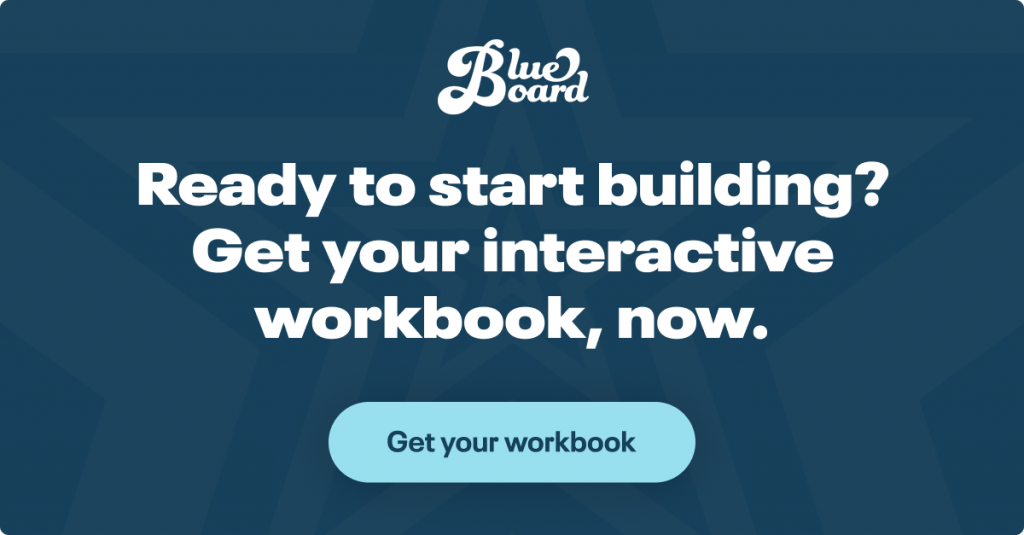
01st June 2023
Guest Post: The Blueboard Method: Your ultimate employee recognition program guide
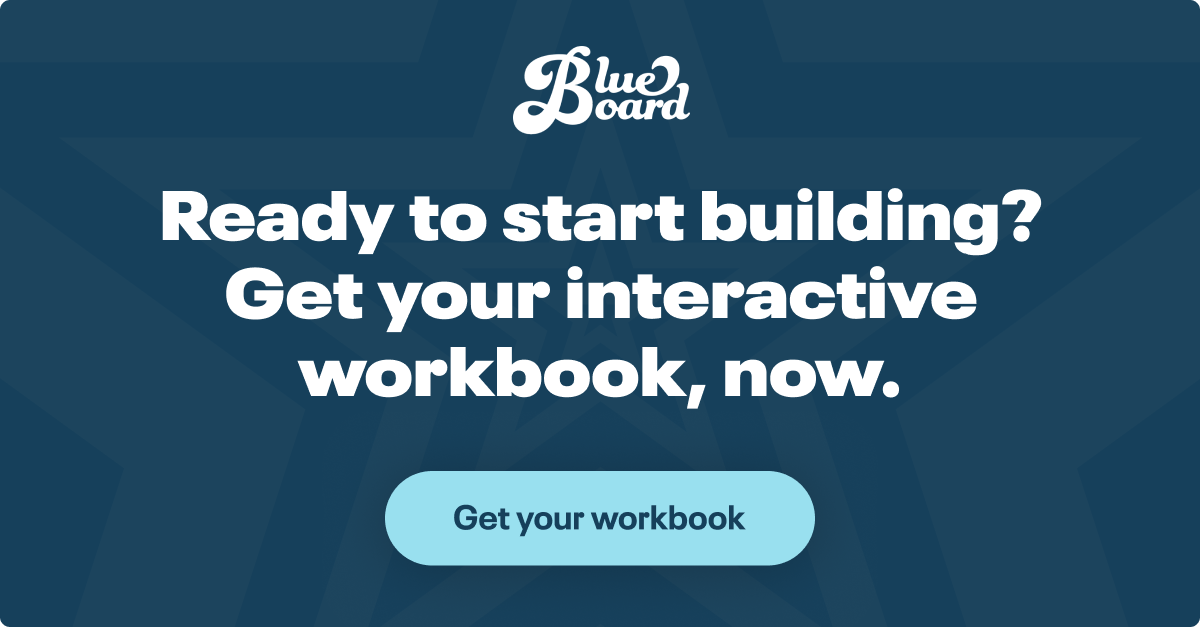
TL;DR Most employee recognition programs are not having the desired impact. Despite major investment, programs are failing to drive: 1) long-term employee engagement and positive sentiment, 2) stellar employee retention, or 3) employee connection to the company.
If these issues sound familiar, this post is for you. In it, we outline The Blueboard Method™—a complete guide and proven approach to better employee recognition that’ll benefit your people and your bottom line.
You’ll come away with:
- Clear steps to the most effective employee recognition program for your organization,
- An actionable framework you can apply to your recognition efforts right now,
- A comprehensive workbook you can use to improve employee recognition and company culture
In our ultimate guide, we’ll show you how to build an employee recognition program that sets your company apart.
Employee engagement is dropping, but employee recognition can help.
We’re in a human energy crisis. And HR professionals are on the front lines in the workplace, navigating their own exhaustion while supporting employees through major workplace shifts—like a global pandemic, remote work, and return-to-office—as well as historic levels of burnout and an increasing sense of disconnection.
Related reading: 6 Self-Care Tips HR Professionals Needed Yesterday | Blueboard Blog
All of this is reflected in decreasing employee engagement, satisfaction, and productivity. Last June, Gallup released survey data from 15,000 U.S. workers that revealed almost 50% were not engaged at work. Worker satisfaction has been steadily decreasing over the past two years and productivity has also been dropping in non-manufacturing sectors.

This graph from The Washington Post shows declining labor productivity over the past few years, with an especially noticeable dip since 2022.
It can feel like a really high mountain to climb. A never-ending, push-a-rock-up-a-hill situation. But there is good news: A company culture of appreciation and recognition can have a major positive impact on you, your people, and your business.
According to The Josh Bersin Company, a research and advisory company for corporate learning, talent management, and HR, companies that have appreciation embedded into their culture are 6x more likely to have high engagement and retention:
“We know that appreciation through gratitude and praise can affect employee wellbeing both directly and indirectly. Gratitude helps people connect to something larger than themselves. Workers formally praised for their contributions report higher levels of happiness, productivity, and loyalty. But it doesn’t just work for the person receiving the praise. People who praise others have improved metabolism and [lower] stress levels.”
Original data from Blueboard and Wakefield Research also validates this, showing that employees who feel appreciated are 4x more likely to report an engaged workforce and 7x more likely to report feeling secure in their jobs.
All this begs the question: If a culture of appreciation and recognition is so impactful, why aren’t more organizations investing in them?
Most employee recognition programs miss the mark. Here’s why.
In short: We’ve been taking the wrong approach to employee recognition. And because of this, those recognition efforts rarely drive the impact we’re looking for—which means leaders can be even less inclined to put energy into it. And so the cycle continues.
When employee recognition is an afterthought, it can have little to no (or even negative) impact on the employee experience. This might look like:
1. Recognition that feels transactional.
In his book, Predictably Irrational, Dan Ariely describes how we live in two different worlds: one where social norms prevail, and the other where market norms dictate how we act. Asking a friend to help you move? Social norm. Paying a contractor to help you move? Market norm.
Employee recognition is a social norm, but organizations often treat it like a market norm. Recognition should thank your employees for their hard work and show them how much you value their contributions, but so many organizations express this gratitude with something impersonal, like cash or a gift card. This strips away the sincerity of the recognition moment, and it also diminishes its impact.
2. Recognition that doesn’t have the desired impact on employee performance.
Without an “always-on” recognition program driven by a core strategy, recognition impact—on individual employees and on organizational culture—is stunted. An employee might get a “thank you” and a gift card for one positive action and zero recognition for another positive action.
This inconsistency makes it difficult for employees to get motivated to earn recognition. And when recognition doesn’t align with employee expectations, it may not have any impact on employee morale and motivation at all or it might have a negative impact.
3. Recognition that isn’t equitable across the organization.
Strategy and structure support equity, while a lack of intention often leads to inequity. We see this in the way inequity shows up in every corner of the workplace—from race and gender-related representation and pay gaps to differences in access to basic needs like healthcare—and it holds true for recognition. Organizations that don’t have a core recognition strategy might see a healthy culture of recognition on one team, while other teams and departments might lack recognition touch points entirely.
This creates a disparity in how team members are supported and these types of disparities can damage company culture and employer brand. If you want your people to have equitable access to meaningful recognition, a strategic approach is a must.
To be truly impactful, employee appreciation and recognition must be cultural.
A company culture of recognition centers the practice of acknowledging, appreciating, recognizing, and rewarding employees for their labors—both within their job responsibilities and outside the confines of their roles (think culture- and community-building work).
It embeds the practice of recognition into company tenets (core values, vision, mission) and the structures that support company culture. And it manifests in employees across an organization recognizing their peers, performing consistently, and co-creating a work environment where people feel seen, valued, and appreciated.
Building this culture of recognition requires intention. It requires introspection and an understanding of where your company is today and where you want to be in the future. It requires an understanding of the different recognition levers you can pull as a leader and an organization. And, at Blueboard, we believe effective employee recognition requires an entirely new methodology to have a meaningful impact on your people and drive real results.
Build a company culture of recognition with The Blueboard Method.
Based on our work with hundreds of organizations across industries, The Blueboard Method™ combines elements of known recognition best practices with our unique experiences-based approach into an actionable, step-by-step framework that’ll help you build a culture of recognition that’ll set your company and employee experience apart.
Ready to put The Blueboard Method into action? Get your interactive workbook and start building.
Here’s how it looks at a high level:
Step 1: Identify goals for your employee recognition program(s).
Most organizations are looking for their employee recognition programs to impact a few key “people” metrics:
- Employee engagement,
- Employee productivity,
- Employee retention
But it’s important to get as specific as possible in the goal-definition stage—these goals will inform the types of recognition programs you’ll want to introduce, and how best to mature your approach to recognition. Look to employee feedback and engagement surveys to help you diagnose and articulate your most pressing gaps; then, use that information to define your goals.
Here’s an example of how to get started with outlining the “opportunity areas” to address with employee recognition, your ideal outcomes, and how to measure impact:
- Identify the pain point or problem(s) to address: Employee engagement overall is down at your organization. In looking at employee surveys, you realize that employees are feeling disconnected from your organization’s purpose—from your vision, mission, and values. This disconnect has gotten particularly bad over the past few years as you’ve transitioned to hybrid work.
- Clarify desired outcomes: A central goal for your employee recognition program, then, becomes: “To nurture employee connection to our organization’s vision, mission, and values.”
- Consider metrics for success: As you’re working to define your most important goals, consider how you’ll measure impact. In the example above, you’d want to set a benchmark for any initiatives that relate to “employee connection to company purpose” before you introduce your recognition program, and establish a regular cadence of checking in on that benchmark (quarterly, annually, etc).
By documenting impact against clear goals, you’ll build credibility with executive leaders and set yourself up to unlock additional budget and resources to continue to develop your employee recognition program and approach.
Step 2: Lay a solid foundation for multi-dimensional employee recognition.
At a foundational level, The Blueboard Method relies on a known, three-dimensional approach to employee recognition, which includes:
- Day-to-day employee recognition and appreciation
- Informal employee recognition
- Formal employee recognition

Our interactive workbook will help you map your recognition goals to different employee recognition programs across each of these three tiers, so you can begin to build your ideal “program mix”.
For example, day-to-day employee appreciation and recognition might look like:
- Weaving public recognition in the formshout-outs into your company all-hands,
- Asking managers to send notes of appreciation on a regular cadence,
- Facilitating consistent peer-to-peer recognition with a tool or app
These efforts and programs can all support the following organizational goals:
- Improve employee morale
- Nurture employee connection
- Reinforce company values and culture
- Reduce the impact of silos/share wins
- Promote equity and inclusion
Often low-cost and low-effort, the benefits of day-to-day appreciation and recognition include reinforcing positive behavior in the moment, and building employee connection and overall goodwill. (Remember: expressing gratitude for great work has positive impacts all around, on the giver, the receiver, and the culture!)
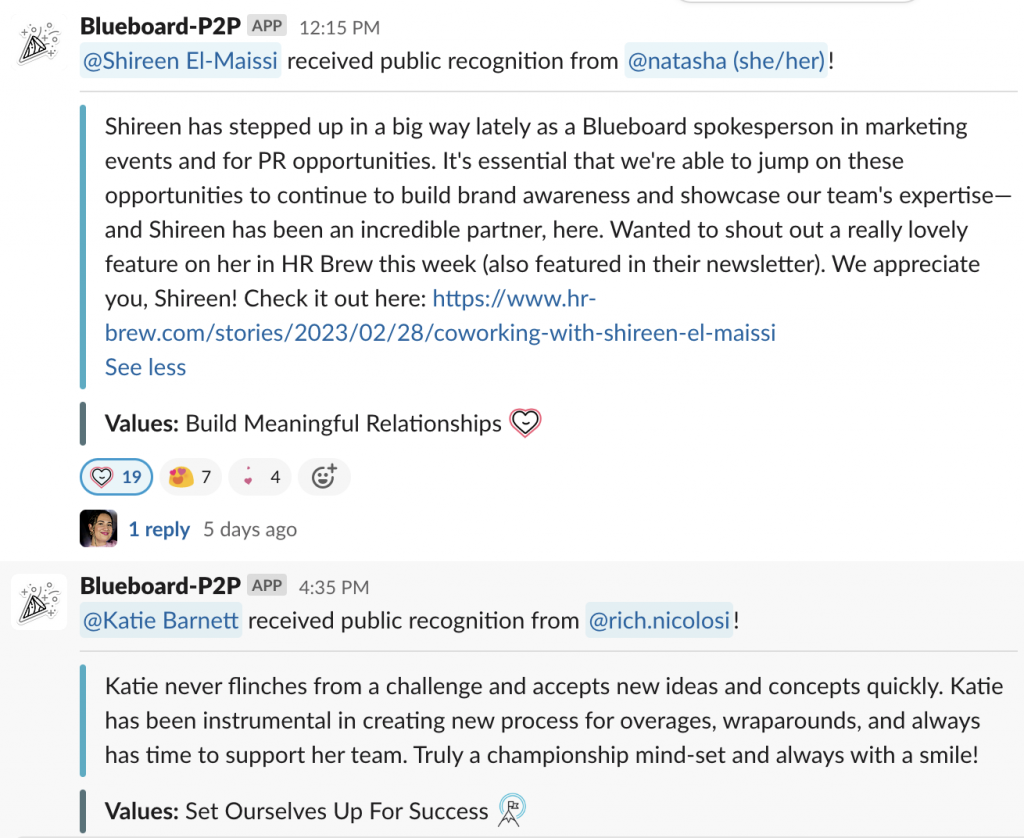
An example of day-to-day employee appreciation and recognition with the Blueboard peer-to-peer app.
Of course, day-to-day appreciation alone does not a culture of recognition make. Organizations should also be recognizing significant employee achievements with more gusto, which brings us to informal recognition programs and formal recognition programs.
These programs are equally important pieces of your overall recognition puzzle. And because they’re tied to a reward, you can use them to have a more targeted impact on critical employee performance and long-term employee retention.
Ultimately, this multi-tiered approach creates complete recognition coverage and ensures every employee has multiple opportunities to be recognized for their contributions and milestones. This is key to creating a sustainable culture of recognition—and a successful employee recognition program—that powers employee experience and drives engagement and retention.
Get The Blueboard Method workbook to see: the recognition goals supported by informal and formal programs, examples of these programs, and benefits to your organization.
Step 3: Amplify recognition impact with The 5 As.
Think of the three dimensions of recognition as making up the base of your company culture of recognition. They’re foundational to an effective recognition strategy—but this base alone won’t help you achieve the business results or answer the lingering questions that status quo recognition misses, like:
- How do we drive long-term impact from our recognition efforts?
- How can we create a self-sustaining recognition culture?
- How do we boost employee performance with rewards and incentives that truly motivate?
That’s why The Blueboard Method introduces another layer of framework thinking, designed to address these issues: We call it The 5 As™. The 5 As framework harnesses the power of experiential rewards to amplify the impact of your recognition program.

The 5 As offers a framework for how you should think about and execute on your employee recognition programs.
Understanding The 5 As of appreciation.
Within a multidimensional recognition strategy, your organization will be running multiple recognition programs that support goals (like retention, wellness, motivation, and engagement) across the business.
Note that you can only apply The 5 As framework in its entirety to recognition programs that also include a reward (e.g. informal and formal recognition).
1. Awareness.
Great workplace recognition programs are seen, heard, and felt. They demonstrate that your company cares about your people and values their achievements. But if your employees aren’t aware of your recognition program(s)—including their existence, duration, rules, etc.—those programs won’t have any impact on your business, employee satisfaction, or company culture.
This may seem like common sense, but it can be really difficult to keep recognition programs top-of-mind if those programs don’t have any innate virality (or, built-in, effective ways to socialize and keep interest and excitement high with employees). If you, as the program administrator, are constantly having to remind people of your recognition program and push and prod people to participate, you’ll eventually burn out. And the program will lose steam.
The “Experiences” Difference.
The Blueboard Method relies on experiential rewards in part because they support Awareness. Experiences are shareable by nature.
Research shows that people are much more likely to tell stories about their experiences than they are to share about, say, a material possession. Not only are people more likely to talk about their experiences, but hearing about other people’s experiences is less likely to evoke potentially counterproductive social comparison. Meaning, we can share freely about a beautiful experience and our teammates can listen and receive our share without feeling less-than.
This shareability means that employee recognition programs powered by experiential rewards are better set up for success with increased socialization in three key ways:
- Employees talk about their experiences, share about their experiences on internal channels, post about their experiences on social media→
- Their peers and teammates hear these stories and get curious / motivated to earn their own experiential rewards + Potential new hires and partners hear about your innovative rewards→
- You have a program that generates constant buzz, keeping it top-of-mind for your people and feeding your employer brand.
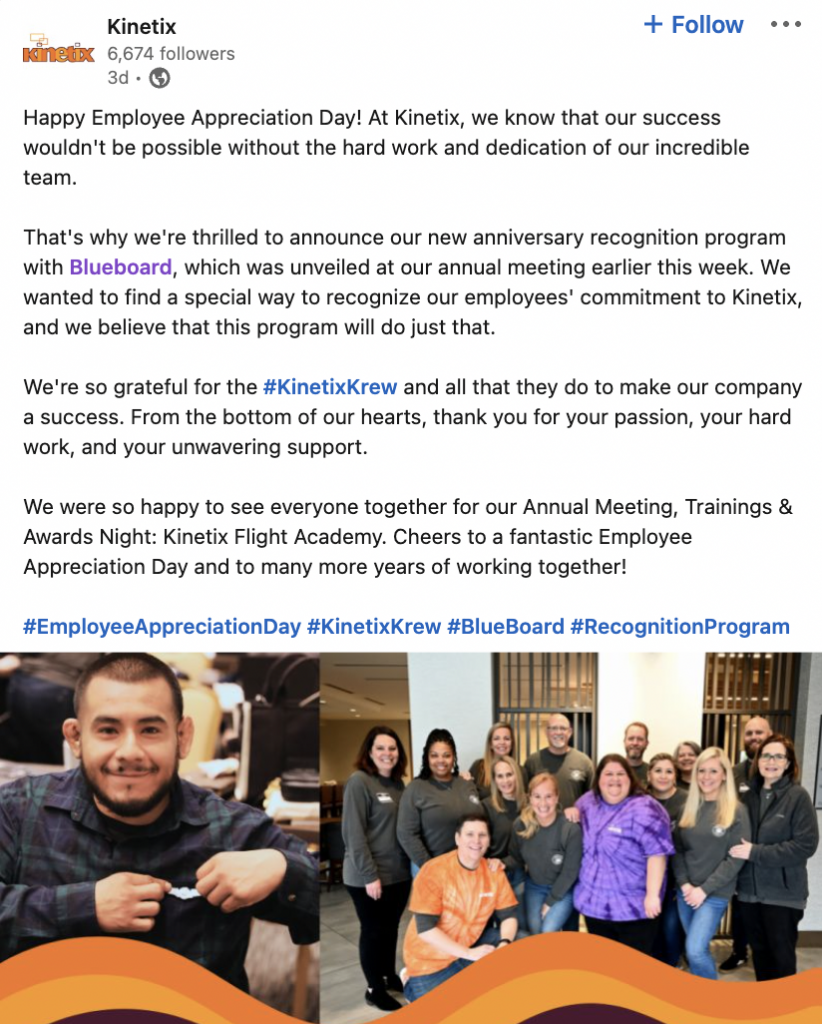
This LinkedIn post by Kinetix is a great example of the enhanced, super visible “shareability” recognition programs create for your people and your brand awareness.
2. Acknowledgement.
Acknowledgement is at the core of every authentic recognition moment. It connects an employee’s action or behavior to a positive, reinforcing message. That “message” might be a verbal thank you, real-time positive feedback, or it might be a note of acknowledgement paired with a bucket-list experiential reward.
Regardless of the message, the goal of “Acknowledgement” is to say: We value you. We see the work you’re doing and we’d like you to continue doing it. You and your unique approach, perspective, skills, talents, and outputs are seen and valued.
Acknowledgement is most effective when it is specific and tied to impact:
- Describe the situation. Make sure the context is clear and specific.
- Describe the employee’s behavior or action.
- Highlight the impact that behavior or action had on you, your team, or your organization.
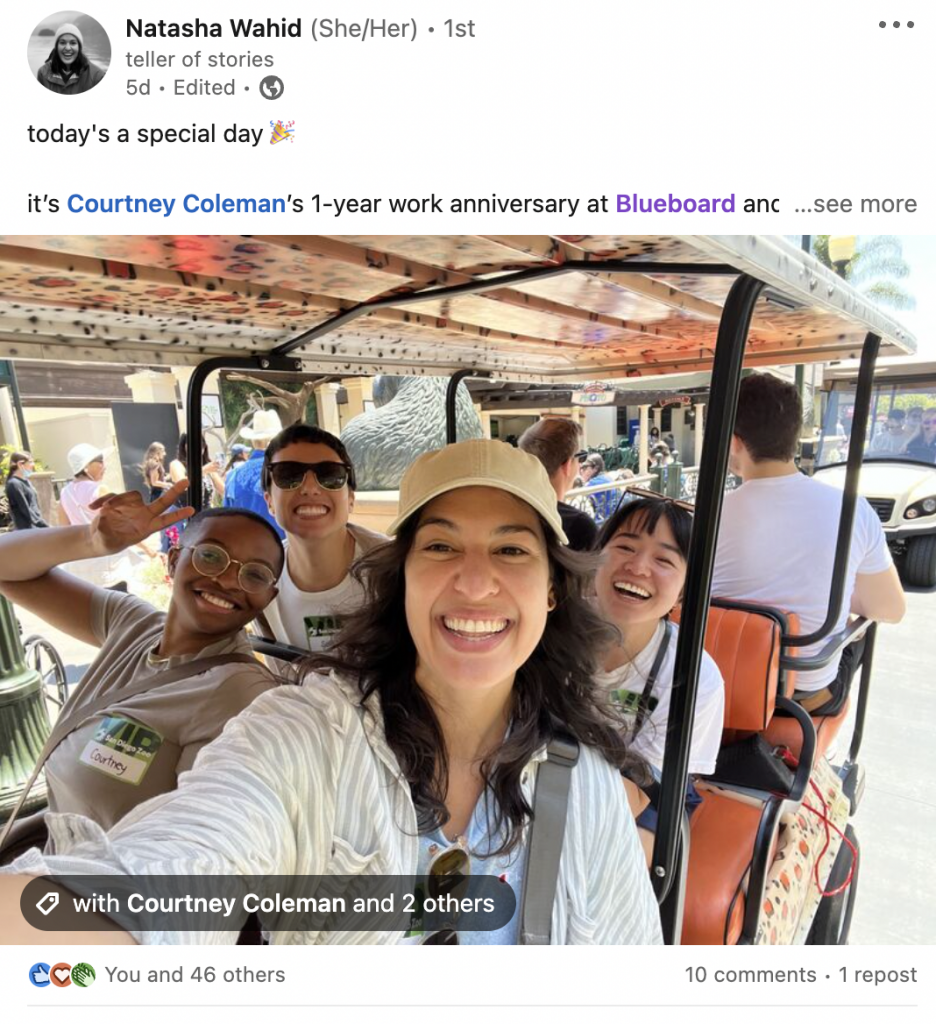
This is my one-year workiversary LinkedIn post for Courtney C., a member of the Content team at Blueboard (and an example of the acknowledgment part of The 5 As). Click the post link to read the specific ways I acknowledge Courtney and her amazing contributions!
The “Experiences” Difference.
Meaningful Acknowledgement doesn’t require a reward. But a meaningful reward will amplify the impact of Acknowledgement. Experiential rewards do this like nothing else because they are personal, nourishing, and empower your people to thrive.
Experiences enhance our social relationships, they’re people-focused and help us create connections, and they help us shape our identity. Experiences make us happier, more connected humans—which means a meaningful experience is invaluable.
When you pair authentic Acknowledgement with an invaluable reward, you create stickiness: The positive reinforcement sticks in your employee’s brain, making them more likely to stay engaged, to repeat those positive behaviors, and to feel loyal and connected to your organization.

Doug B. creates a sailboat during “The Art of Stained Glass” experience, a Blueboard reward Doug received from his employer.
“The best part of the experience,” shares Doug in his post-experience feedback survey, “was finishing my first piece of stainless glass. The instructor was great and she led us through everything step-by-step. I experienced something new.”

Doug B.’s finished stained glass sailboat!
3. Anticipation.
To understand Anticipation, we first need to understand dopamine. Dopamine is a chemical neurotransmitter that’s released from your brain’s frontal lobe. It acts as a stimulant that prevents pain, stimulates arousal, and causes excitement. Simply put: It feels great.
What does this have to do with Anticipation? Well, dopamine stimulation happens when we experience and expect good things. And anticipating positive events sustains the output of dopamine into your brain’s chemical pathways.
Anticipation is a big part of why it’s so important to build recognition programs vs. relying on adhoc recognition. A strategic, holistic recognition approach means employees understand how to earn and unlock recognition, as well as the cadence and levels of recognition. And that understanding allows them to anticipate recognition and reward, which boosts positive feelings and motivation.
The “Experiences” Difference.
Waiting doesn’t always feel good. It can manifest as anxiety, impatience, or frustration. But when we’re counting down the days to our first-ever trip to Vietnam or a long-awaited reunion with friends, the experience of waiting changes. Waiting goes from grating to joyful.
Experiences are especially effective at driving joyful Anticipation. In fact, anticipating an experience (in recognition of your years of service, for example, at work anniversary milestones) is proven to create significantly more enduring, positive emotions than anticipating buying a material good. This Anticipation also contributes to the long-term positive associations that will accompany the memories your employees will make as they enjoy an experiential reward. (More on this when we talk about Afterglow.)
4. Activity.
When we talk about employee recognition tied to a reward, we’re often talking about gift cards and monetary rewards like cash bonuses. For some organizations, employees earn points to put toward a material good. There are arguments to be made in favor of these types of monetary value-based rewards: Cash, for example, is more fungible and easier to give.
But The 5 As framework doesn’t hold space for these types of rewards—and that is by design. Instead, it asks leaders to go further and consider how you can give your people the gift of time. Time to spend challenging their comfort zones, indulging in their passions, or trying something new. Time to spend connecting with loved ones and with their community.
By replacing “reward” with Activity, The 5 As framework is really asking organizations to use non-monetary rewards as a way to help their employees find fulfillment. The reward is about removing all of the barriers that prevent us from enjoying any of the many activities we dream about, but put on the backburner because … well, life.
But when an organization can sponsor an employee’s chosen Activity as part of a meaningful recognition moment, that organization is investing in that employee’s whole self. It is showing that that employee, along with their good work, is truly valued.
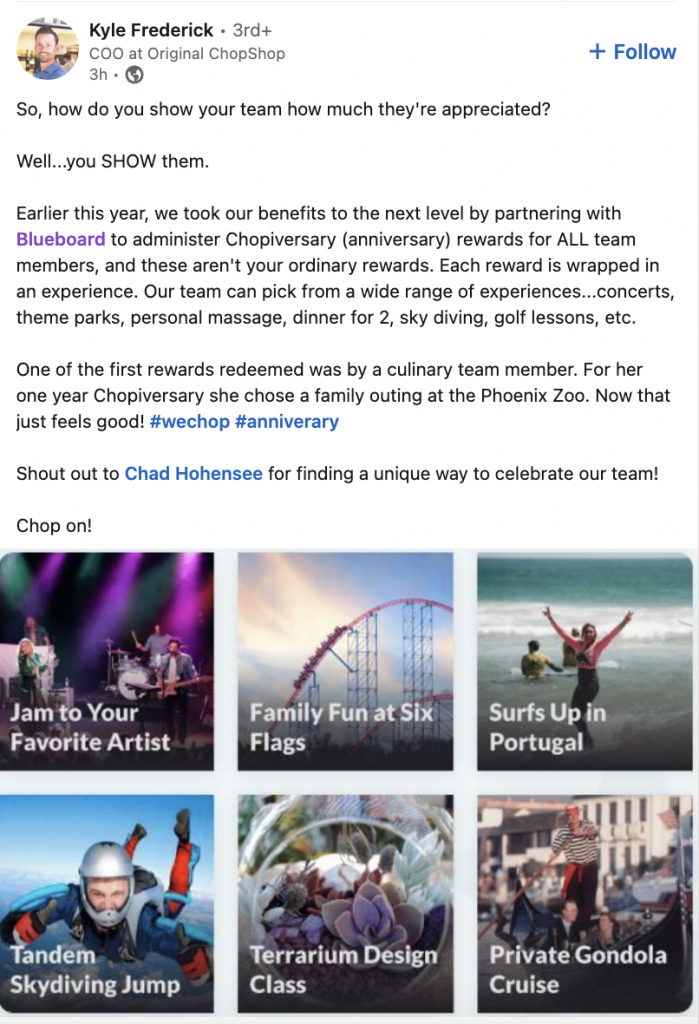
ChopShop COO Kyle F. shares why they appreciate and recognize their employees’ work anniversaries with Blueboard experience rewards.
The “Experiences” Difference.
An experiential reward revolves around an Activity. Ideally, you can offer a wide variety of activities so that every employee, regardless of their preferences and circumstances, can find the perfect Activity for them. This might look like getting the materials and guidance to level-up your at-home patio, it might look like spending time at a spa with your partner, it might look like feeding sharks at the aquarium with your kids, it might look like learning the instrument you’ve always wanted to learn …
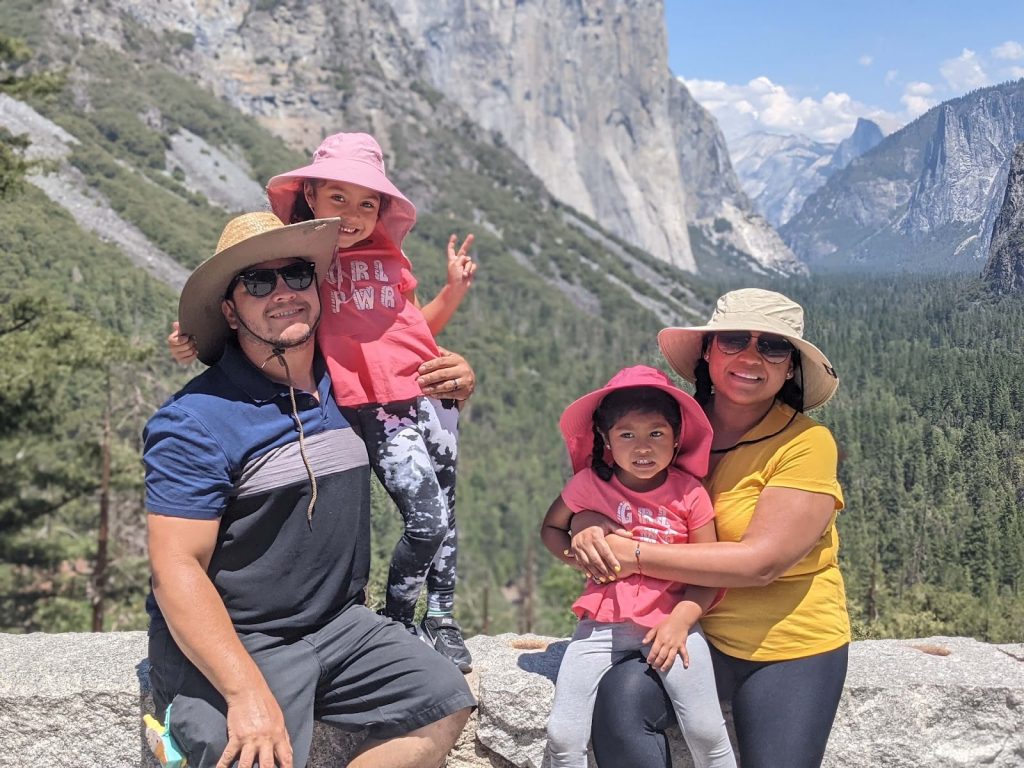
Yaneyra N. and family pose for a scenic photo while on the “Go Glamping” experience, a Blueboard reward from their employer.
When you reward your people with experiences, you’re rewarding them with the most scarce and valuable currency of all: Quality time to spend doing exactly what they want to do with the people they love most.
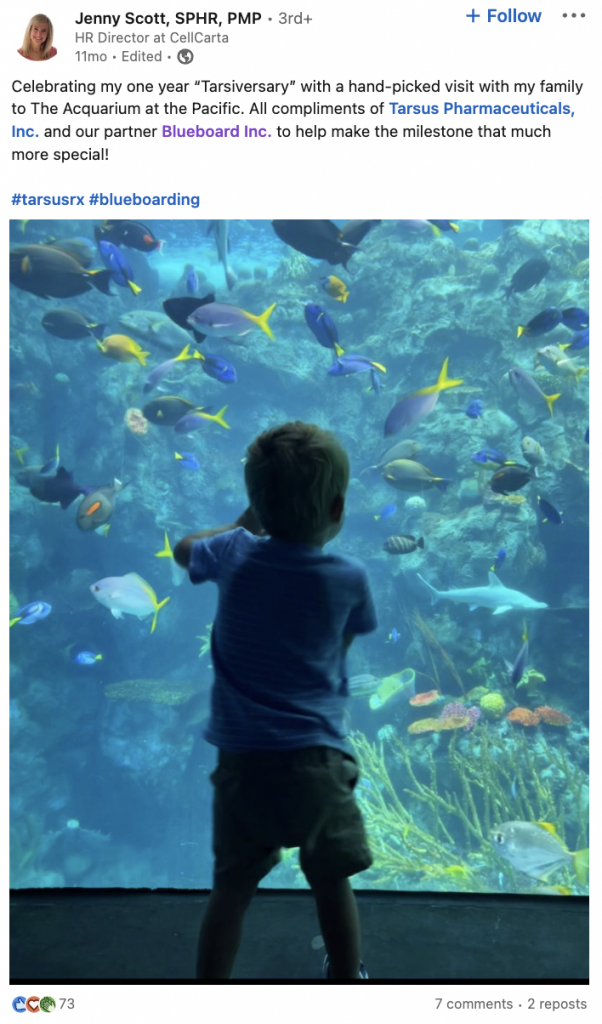
Jenny S. shares a photo from a day spent with family at an aquarium—a Blueboard experience she chose for her one-year work anniversary reward from her workplace.
5. Afterglow.
Afterglow refers to the period of time after an employee receives recognition and/or a reward, when the employee is reflecting on and basking in any positive feelings created. A lengthy Afterglow period is more likely to drive long-term employee motivation, engagement, and loyalty.
With traditional recognition and rewards, the Afterglow period is relatively short. A cash bonus, for example, is often conflated with income. Unless it’s a life-changing sum, the impact of this kind of reward fades quickly, as it gets applied to monthly bills or disappears into your employee’s checking account.
On the other hand, employee recognition ideas such as a handwritten, heartfelt note of appreciation from a beloved manager can extend Afterglow—but even in these cases, a note might not create a memory. And it’s in memory that Afterglow flourishes.
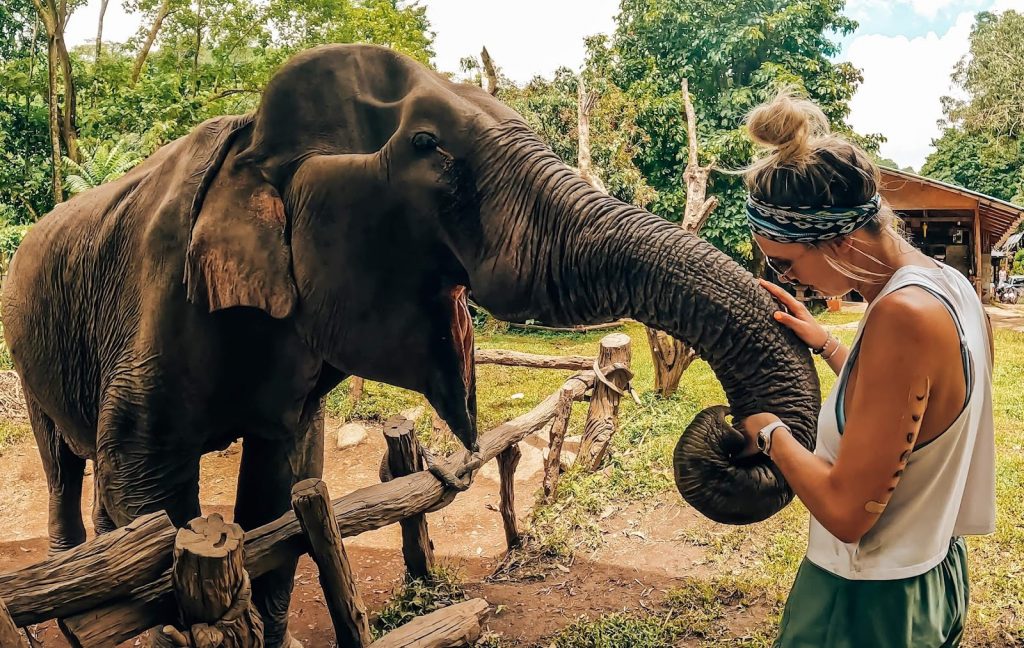
Ali A., Account Executive at Blueboard, spends time with the elephants in Thailand as part of a Blueboard experience trip.
“Last summer, I redeemed my referral rewards to take one of my best friends to Thailand. I think the most impactful thing was being able to treat my friend to her first major international trip. Watching her eyes open to such a new experience and culture was truly magical, and made me elated to share my passion of travel! Some of the coolest experiences of my life have been thanks to Blueboard in the last 5 years, and I feel so lucky to work for a company that aligns with my personal values.”
The “Experiences” Difference.
When it comes to long-term Afterglow, experiences reign supreme. Because experiences become memories.
When you pair recognition with an experiential reward, an employee is able to choose the Activity or experience that fits their needs and desires in whatever moment they’re in. They’re able to share that Activity with their loved ones (or experience it solo if that’s what feels right). And afterwards, this experience becomes a memory and—ultimately—becomes part of their identity.
When we reflect on a past experience, whether it’s days, weeks or years later, we are subconsciously asking ourselves contextual questions:
- “What was I feeling when I jumped out of the plane?”
- “How have I changed since then?”
- “How thankful did I feel when my feet finally hit the ground?”
It’s these subtle, personal evaluations that solidify memories and add complexity and depth to our identities. These memories create positive feelings that can literally last forever. And when your organization is the root cause of these beautiful memories, those positive feelings stay associated with your company and culture.
Get The Blueboard Method workbook for real-world examples of recognition program design and The 5 As in practice.
Set your organization up for success with a better approach to employee rewards and recognition.
As an organizational leader, employee recognition is one of the most powerful tools at your disposal. People who feel appreciated and recognized at work—for who they are and for their unique contributions—are much more likely to be engaged, to perform at a high level, to cultivate positive culture and better teamwork, and to champion your company and solutions.
But the secret to truly effective employee recognition lies in your approach. To that end, we hope The Blueboard Method gives you actionable tools you can use to build a recognition and rewards program that has a profound impact on your people and your business.
As you march forward to build or evolve your employee recognition program, remember these core questions:
- What are we trying to achieve with employee rewards and recognition? What are our core goals?
- What programs do we have in place (or want to put in place) across the three dimensions of recognition? How do these programs support our core goals?
- How will we make sure recognition is equitable and accessible across our organization? How will we provide complete recognition coverage?
- How are we applying The 5 As framework to our different recognition programs to amplify recognition impact?
- How are we evaluating recognition program impact according to our core goals?


